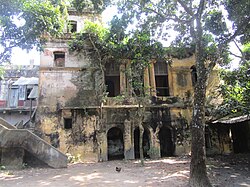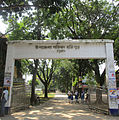Haripur Upazila
Haripur
হরিপুর | |
|---|---|
 Haripur Rajbari | |
 | |
| Coordinates: 25°48.5′N 88°8.5′E / 25.8083°N 88.1417°E | |
| Country | |
| Division | Rangpur |
| District | Thakurgaon |
| Area | |
| • Total | 201.07 km2 (77.63 sq mi) |
| Population | |
| • Total | 159,516 |
| • Density | 790/km2 (2,100/sq mi) |
| Time zone | UTC+6 (BST) |
| Postal code | 5130[2] |
| Website | Official Map of Haripur |
Haripur (Bengali: হরিপুর) is an 70205 code upazila of Thakurgaon District in the Division of Rangpur, Bangladesh.[3]
Geography
[edit]Haripur is located at 25°48′30″N 88°08′30″E / 25.8083°N 88.1417°E. It has 32,607 households and total area 201.06 km2.
Haripur upazila is bounded by Ranisankail Upazila on north and on the east, Hemtabad and Raiganj CD blocks in Uttar Dinajpur district, West Bengal, India, on the south and Karandighi and Goalpokhar I CD blocks in Uttar Dinajpur district on the west.[4][5][6]
Demographics
[edit]According to the 2011 Census of Bangladesh, Haripur Upazila had 32,607 households and a population of 147,947. 38,208 (25.83%) were under 10 years of age. Haripur had a literacy rate (age 7 and over) of 42.14%, compared to the national average of 51.8%, and a sex ratio of 994 females per 1000 males. 7,288 (4.93%) lived in urban areas.[8][9]
As of the 1991 Bangladesh census, Haripur has a population of 101658. Males constitute 50.93% of the population, and females 49.07%. This Upazila's eighteen up population is 49922. Haripur has an average literacy rate of 19.5% (7+ years), and the national average of 32.4% literate.[10]
Administration
[edit]Haripur Thana was formed in 1914 and it was turned into an upazila in 1983.[12]
Haripur Upazila is divided into six union parishads: Amgaon, Bakua, Bhaturia, Dangipara, Gedura, and Haripur. The union parishads are subdivided into 75 mauzas and 70 villages.[8]
Gallery
[edit]-
Amai Pond at Haripur Upazila Parishad
-
Haripur King's Palace
-
Haripur Pilot High School
-
Haripur Girls High School
-
Nagor River at Indo-Bangladesh Border
-
Haripur Upazila Parishad Entrance
See also
[edit]References
[edit]- ^ National Report (PDF). Population and Housing Census 2022. Vol. 1. Dhaka: Bangladesh Bureau of Statistics. November 2023. p. 403. ISBN 978-9844752016.
- ^ "Bangladesh Postal Code". Dhaka: Bangladesh Postal Department under the Department of Posts and Telecommunications of the Ministry of Posts, Telecommunications and Information Technology of the People's Republic of Bangladesh. 21 October 2024.
- ^ Md. Abdul Gaffar (2012), "Haripur Upazila", in Sirajul Islam and Ahmed A. Jamal (ed.), Banglapedia: National Encyclopedia of Bangladesh (Second ed.), Asiatic Society of Bangladesh
- ^ "Haripur Upazila". Banglapedia. Retrieved 6 January 2019.
- ^ "District Census Handbook Uttar Dinajpur, Series 20, Part XII A" (PDF). Map of Uttar Dinajpur district on the fifth page. Directorate of Census Operations, West Bengal. Retrieved 6 January 2018.
- ^ "District Human Development Report". Uttar Dinajpur. Page 14: Map showing locational setting of Uttar Dinajpur district (includes Dakshin Dinajpur district). Department of Planning, Statistics and Programme Implementation, Government of West Bengal. Archived from the original on 19 January 2018. Retrieved 6 January 2019.
- ^ Population and Housing Census 2022 - District Report: Thakurgaon (PDF). District Series. Dhaka: Bangladesh Bureau of Statistics. June 2024. ISBN 978-984-475-283-2.
- ^ a b "Bangladesh Population and Housing Census 2011 Zila Report – Thakurgaon" (PDF). bbs.gov.bd. Bangladesh Bureau of Statistics.
- ^ "Community Tables: Thakurgaon district" (PDF). bbs.gov.bd. Bangladesh Bureau of Statistics. 2011.
- ^ "Population Census Wing, BBS". Archived from the original on 2005-03-27. Retrieved November 10, 2006.
- ^ "Haripur UNO". haripur.thakurgaon.gov.bd. Retrieved 2024-08-27.
- ^ "Haripur Upazila - Banglapedia". en.banglapedia.org. Retrieved 2023-02-21.







